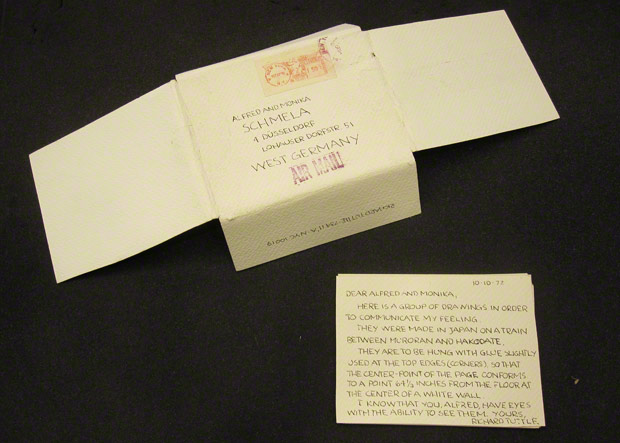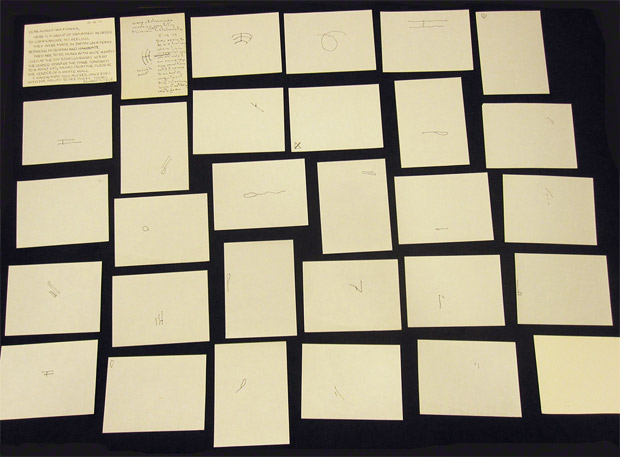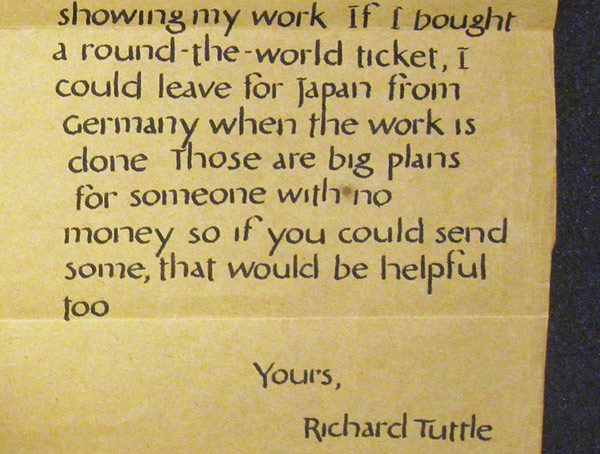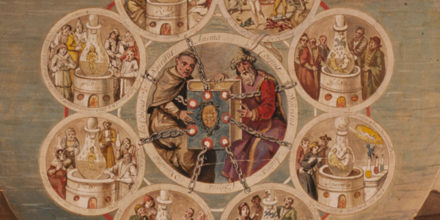As I was recently working on the archive of the German art dealer Alfred Schmela, I discovered an unusual mailing sent by American postminimalist artist Richard Tuttle.
Addressed to Alfred Schmela and his wife Monika in Düsseldorf, Germany, it was sent from New York on October 13, 1978. Laid into a handmade envelope are 27 drawings executed in black pen on thin white paper. All sheets measure 11 x 15 cm. On an additional sheet inscribed by Tuttle and dated May 16, 1977, he explains the drawings: “They seem to be a situation where I am suspended having to know on which side I am on—a very nice condition until it comes to an end of recognition of this, but one can laugh at not being able to go on.”

Letter from Richard Tuttle to Alfred and Monika Schmela, 1978. Galerie Schmela records. The Getty Research Institute, 2007.M.17. © Richard Tuttle; used with permission
Two cards on thick white paper are laid into the handmade envelope. One is blank, and the other is a letter from the artist to the Schmela couple written neatly in black ink in capital letters and dated October 10, 1978. Tuttle writes, “Here is a group of drawings in order to communicate my feelings. They were made in Japan on a train between Muroran and Hakodate.”
Tuttle also describes how the drawings should be arranged in equal and precise distance from the floor and to each other and glued to a white wall in gallery space. He adds that Alfred Schmela has “eyes with the ability to see them.”
There is only one drawing on each sheet, placed randomly and spontaneously in the middle, in a corner, or near the margin. Most drawings are small, some are almost barely noticeable. Each one is unique and simple in shape. Some lines circle and cross, some are parallel and connect occasionally with other lines drawn across. Executed gently with ink, all the drawings appear delicate and timid.
The drawings express the artist’s feelings subtly and elusively, and the randomness and spontaneity of the drawing process and the simplicity of forms gives the drawings an intimate poetic quality.


Sketches included in a 1978 letter from Richard Tuttle to Alfred and Monika Schmela, 1978. Galerie Schmela records. The Getty Research Institute, 2007.M.17. © Richard Tuttle; used with permission
This is one of several artworks by Richard Tuttle I discovered in the Schmela Gallery archive. There are handmade Christmas cards, a holiday greeting card, and an exhibition announcement designed by the artist. Several of Tuttle’s letters include small drawings and paintings.
In 1968 Tuttle wrote Alfred Schmela a couple of letters in calligraphy, which is his own in form and style. Especially the letter dated simply “Monday” and sent from New York on April 9, 1968, testifies to Tuttle’s interest in the alphabet as art.

Detail of calligraphy in a letter from Richard Tuttle to Alfred Schmela, 1968. Galerie Schmela papers. The Getty Research Institute, 2007.M.17. © Richard Tuttle; used with permission
The exhibition announcement found in the archive also includes letters designed by Tuttle. Present, too, in the archive are Tuttle’s hand-drawn instructions on how to install his artworks Sculpture in Drawing Space #7 and a wire octagonal.
Alfred Schmela (1918–1980), considered one of the most influential art dealers in Europe during the 1960s and ’70s, was the first to organize a solo show of Richard Tuttle in Germany and in Europe. The exhibition was called Cloth Pieces und Skulpturen (Cloth Pieces and Sculptures) and took place from March 26 to April 17, 1968, at the gallery space at Luegplatz in Düsseldorf.
Art critic Helga Meister wrote about the exhibition in a local newspaper: “The avant-garde art dealer Schmela is right by saying he has discovered an artist. His [Tuttle’s] works are secretly poetical and of a primitive sensibility. The most stunning thing about this artist is that he gives minimal art a new and fuller dimension.”
The second solo show of Tuttle’s drawings took place from October 7 to November 4, 1978, at Alfred Schmela’s new gallery space in Mutter-Ey-Strasse in Düsseldorf. I wondered if the letter from Japan, sent on October 13, 1978—along with instructions how to install the show—was meant to be added to the already running exhibition? Or if it was ever shown at the Schmela gallery? The answer to these and other questions may yet be found among the correspondence between Tuttle and the Schmela family, which also forms part of the Galerie Schmela records.

See all posts in this series »




Comments on this post are now closed.